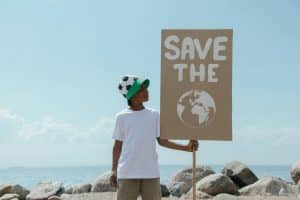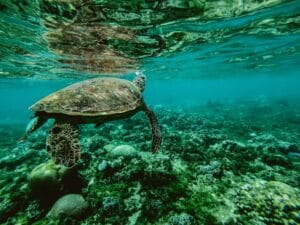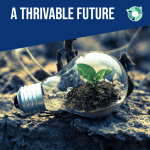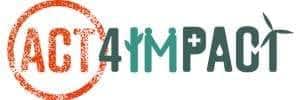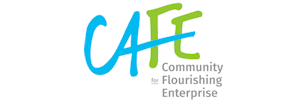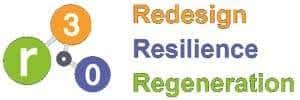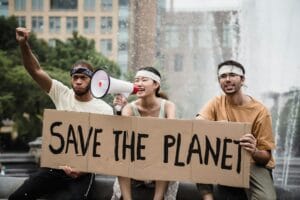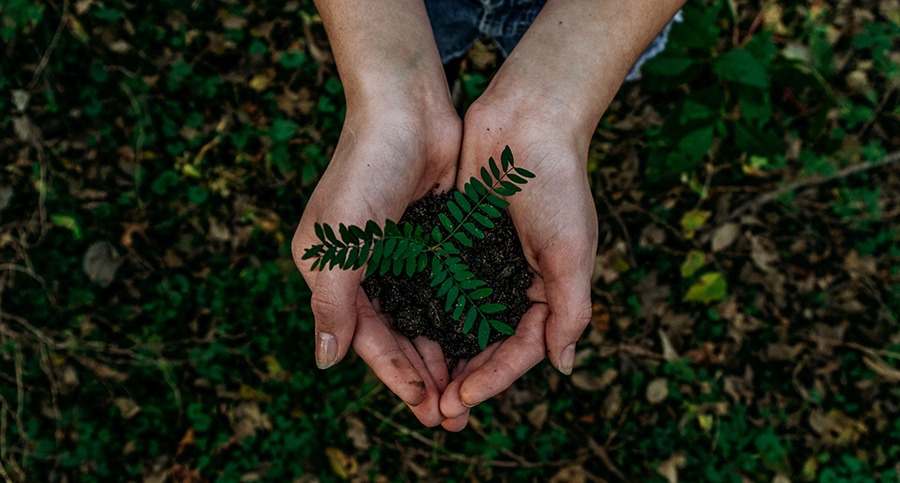Approximately 1000 rivers worldwide contribute to the majority of ocean pollution (The Ocean Cleanup, 2021). Ocean pollution is a significant threat to marine life and ecosystem health, concerning the THRIVE Focus Foundational Factor (FFF) of Strong Sustainability. This FFF works towards creating an evironment that benefits nature. This pollution also impacts human health and recreational activities. Plastic floating in bodies of water often becomes consumed by marine animals such as turtles and birds. If a turtle ingests a plastic bag, it can act as an internal flotation device, preventing the turtle from diving and finding food.
The issue of plastic Pollution
Increasingly, marine birds with stomachs full of plastic are found dead along the beaches, having starved to death. Finite Resources, the FFF, realted to the use of resources that are scarce, is relevant here as birds are ingesting plastic in place of food. Even when not consumed, plastic is still a threat to marine health, becoming a strangulation hazard. Large amounts of plastic can also sit on top of the water, blocking sunlight and preventing the growth of marine grasses. A lack of grass means less food for herbivorous marine species and less prey for the creatures who hunt in the grass.
Plastic pollution is a major issue for humanity, prompting the use of Values-Based Innovation to find solutions. Plastic rubbish in the oceans has been building up for decades, saturating waterways and culminating in ‘rubbish islands’ stranded in the oceans. These are large patches of rubbish floating mostly below the surface in five areas across the globe. The largest is between Asia and North America in the Pacific Ocean.
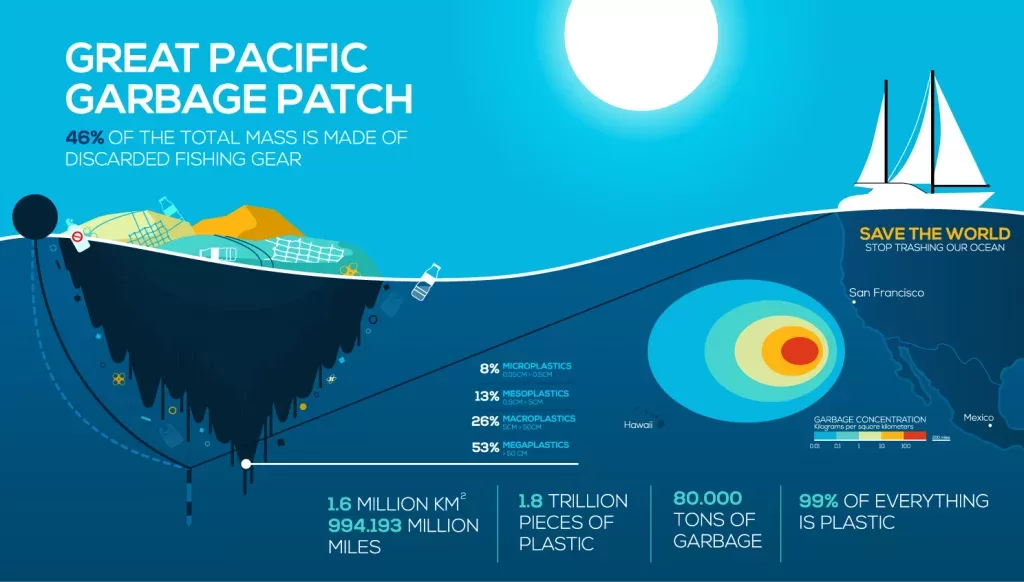
Source: Global Trash Solutions
Most of this rubbish joins the water system in a river. While many river cleaning solutions have been touted, none have made a significant impact. Integral Thinking, an FFF, is required to understand the complexities of cleaning our waterways. However, plastic interceptors offer a revolutionary solution devised to remove plastic rubbish before it can enter the ocean, effectively limiting the growth of the rubbish islands and improving river quality. Without action, plastic rubbish is expected to triple by 2040, with the majority of this ending up in the ocean.
What Are River Cleaning Interceptors?
Interceptors are a type of river cleaning system that work to trap plastic and other rubbish without restricting waterflow or animal movements (Mackrill & Aide, 2024). Invented by 18 year-old Boyan Slat in the Netherlands, through his company Ocean Cleanup in 2013, interceptors have revolutionised rubbish removal and river cleaning. Now, with over ten years of river cleaning experience, efforts are still expanding, removing tonnes of rubbish from rivers worldwide.
There are five types of interceptors: Original, Barrier, Tender, Barricade, and Guard. Each type of interceptor suits a different situation and river system. Every situation of river pollution set for an interceptor goes through an analysis. This determines which type of interceptor is best suited for that particular river. Interceptors use a unique barrier system that effectively sorts through the rubbish, blocking the plastics passage to the ocean. Blocking passage to the ocean enables removal for sorting and recycling while limiting boat or animal restrictions. As interceptors have little negative environmental impact while effectively cleaning river systems, they are being hailed as a gamechanger in water cleaning systems (Ocean Cleanup, 2025).
How Do Interceptor Systems Work?
Interceptor Original
Interceptors use 100% solar power to combine a barrier, conveyor belt, and shuffle system to sort clean water and separate it from pollutants (Ocean Cleanup, 2025). The interceptor autonomously sorts and guides rubbish into the interceptor. Fish and other animals are able to swim out of the path, reducing the likelihood of accidental deaths. The plastic then flows onto the conveyor belt where a skip collects the rubbish, ready for transport to a sorting facility. One interceptor can take up to 100,000kg of rubbish out a river each day.
Source: The Index Project, 2021
Interceptor Barrier
Often used with an Interceptor Tender, this is a standalone, floating device that prevents debris from moving past the mouth of the river. Interceptor Barriers, optimised for smaller rivers, require no electricity, although it necessitates manual extraction of debris, usually by an interceptor tender. Interceptor Barriers, made from plastic recycled from rivers, create a sustainable cycle of the plastic rubbish. These barriers are also cheaper to create and run than interceptor originals.
Interceptor Tender
A mobile barge that collects plastic debris trapped by an interceptor barrier. One tender services multiple barriers.
Source: CNET, 2022
Interceptor Barricade
The interceptor barricade is a series of barriers designed for situations of high flow of both water and rubbish. The first barrier traps as much plastic as possible and a second barrier downstream picks up the overflow. This barrier was a second attempt at stopping a rubbish tsunami that occurs every year in Guatemala, following flood events.
The creation of the Interceptor Guard.
Source: The Ocean Cleanup, 2023
Key Benefits of Using Interceptors for River Cleanup
As each interceptor can remove up to 100,000kg of plastic pollution from a river per day, they significantly reduce river pollution, improving the environment, and mitigating plastic ingestion by marine species.
Key benefits of interceptors include:
- efficency
- environmentally viable
- no harm to wildlife or environmental processes
- improve health of wildlife
- fix the issues caused by humanity
80% of the ocena’s plastic waste arrived via rivers, therefore stopping pollution at the source is a crucial step in mitigation.
Case Studies: Where Interceptors Are Making a Difference
More than twenty interceptors are currently in use across the planet, with hopes to expand to the 1000 most polluted rivers over the next few years. The first four interceptors were deployed in Asia, followed by seven in the Americas
The Chao Phraka River in Bangkok, Thailand is one of the leading contributors to ocean pollution, with 2 million tonnes of rubbish flowing through it each year. As there are many canals leading into the river, cameras had to detect the main sources of plastic in the river to determine the main origins of the plastic in order to ascertain the best implementation practices. This process took two years (The Ocean Cleanup, 2024). Deployment occured in March of 2024 and has been successful in preventing plastic flowing to the ocean.

Source: The Ecologist, 2018
The Future of River Cleanup: What’s Next for Interceptor Technology?
Ocean Cleanup have declared their end goal is to put themselves out of business. They envision a world where river and ocean cleaning is no longer necessary (The Ocean Cleanup, 2025). While the world is not close to this vision yet, progress continues and the interceptors will remain until river cleaning is unnecessary. River interceptors have already removed millions of tonnes of waste from rivers, improving the outlook for ocean health.
Interceptors are receiving woldwide attention, garnering support from groups such as Coldplay, who have sponsored the interceptor deployed in Malaysia (MySailing, 2021) and Marea Verde, a not-for-profit, sponsoring the interceptor to be deployed in their native Panama Bay (The Ocean Cleanup, 2025). Hopefully, the success of these interceptors will expand sponsorship opportunities, allowing for increased deployment and more rivers cleaned. Currently, interceptors cost more than USD$700,00 to produce. By 2040, Ocean Cleanup aims to have cleared 90% of all plastic waste from the planet’s rivers and oceans (NoMilk2Day, n.d.). The end goal for interceptor technology is a clean ocean, with interceptors no longer needed. An estimate of the total cost to end ocean pollution is USD$7.5 billion, less than what Americans spend on Halloween each year (The Ocean Cleanup, 2025).
Conclusion and Call to Action
Interceptors are a great method of reducing the plastic flow to the ocean. However, by themselves they will not solve the problem of ocean pollution (Cho, 2022). They are also in the first stages of ocean deployment, cleaning up the plastic already in the ocean. They are a helpful strategy in mitigating plastic flowing into the ocean while solutions to plastic production are slowly emerging. A reduction or halt in plastic production must occur as soon as possible for the sake of the planet and marine life. This way, the focus can be on clearing the plastic already in the ocean and having a cleaner, healthier planet. Companies such as Hyundai and Coca-Cola partner with the Ocean Cleanup to create new interceptors, but the deployment of interceptors requires more sponsors to clean the 1000 most polluted rivers and keep our oceans clean (The Ocean Cleanup, 2023).
Achieving THRIVE goals
Cleaning the oceans aligns with the United Nations’ Sustainable Development Goal of SDG14: Life Below Water, which aims to conserve the oceans. Cleaning the oceans is essential for both marine and terrestrial life. All life is intertwined and important. Cleaning rivers will provide communities with cleaner water, progressing on both SDG6: Clean Water and Sanitation and SDG13: Life on Land. But these SDGs falls short of action needed, only achieving the bare minimum of what needs to be done. This is where THRIVE’s Foundational Focus Factors (FFFs) feature. These FFFs don’t just aim to conserve, they aim to create conditions where these ecosystems flourish, despite human presence.
One FFF, Strong Sustainability, envisions a world where humans and nature live harmoniously, prospering without detriment to the other. A world that will not exist without clean oceans. The creation of these interceptors uses Integral Thinking, combining a problem with new way of thinking to combat a major worldwide issue. This is an example of Values-Based Innovation, challenging everyday thinking to create new innovations that underline that which people hold dear.
A Thrivable Framework
THRIVE is an acronym for The Holistic Regenerative Innovative Values Entity. It is a not-for-profit organisation tackling many of the world’s problems through its twelve Foundational Focus Factors. These factors go beyond sustainability, to thrivability, where people and nature prosper together. To learn more about thrivability, head to the THRIVE website. Here, you can find published articles, whitepapers, and presentations on a range of thrivable topics. More resources can also be found on the THRIVE YouTube channel. Be sure to sign up for the newsletter and attend the monthly webinars. To contribute more to THRIVE, please volunteer.



